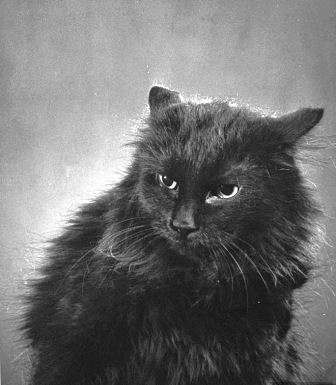
Thomas Wood was one of the many feline tenants of 290 Washington Street, a large, six-story brick factory building on the northwest corner of Washington and Chamber streets. Originally the pet cat of a dye maker at the factory, he made his home on the third floor, which was occupied by the American Wood Decorating Machine Company.
Thomas acquired his surname from employees at Hines & Mansfield, the produce dealers on the ground floor of the building. Employees named all the feline tenants based on the type of company they worked for. Cat surnames included Fruit, Rubber, Wood, and Tin.
A large male cat with jet-black fur “as smooth and glossy as ebony,” Thomas was reportedly the most distinguished of all the “Woods” in the building. He was also known all over the neighborhood as the champion fighter of the factory’s feline colony. His thirst for fighting, however, is what got him in trouble with his employer.
According to The Sun, Thomas howled a lot at night. So much so that nearby residents who wanted to get a good night’s sleep complained about him. They threatened the company to take their complaint to the Department of Health if no action was taken to stop the howls.
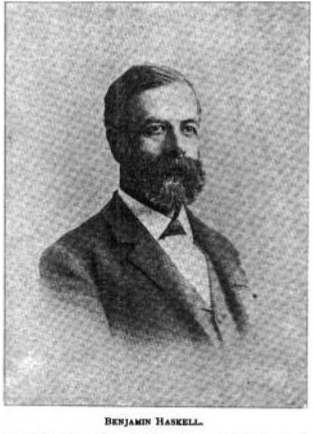
So, Benjamin Haskell, secretary of the American Wood Decorating Machine Company, was forced to let the cat go. Following all the efforts to remove Thomas from the building, Benjamin told a reporter at The Sun all the steps he took to try and remove Thomas Wood.
The Sun reporter noted that Haskell was a church-going man, and therefore, readers should believe his remarkable tale.
According to the story, Benjamin instructed his office boy, Jimmy, to bring the cat to Harlem when he went home after work. Jimmy got an old fruit basket from Hines & Mansfield’s store, stuffed big Tom into it, and carried him up to Harlem on the trolley car.
When he got to Harlem, Jimmy released Thomas Wood on a street corner. The cat ran into the basement of a restaurant, and Jimmy went home satisfied in knowing that he had successfully carried out his orders from Mr. Haskell. Four days later, however, Benjamin found Thomas sitting near the elevator of the factory building at 290 Washington Street.
“I thought I told you to lose that cat,” Benjamin told Jimmy. The office boy said he would try harder next time.

Jimmy borrowed another old basket, stuffed the big cat inside, and took him downtown to the Battery. He left the cat on one of the freight piers below Washington Market. The next morning, however, several employers from W.H. Cummings, a scrap rubber dealer on the second floor, found Thomas sitting on a narrow wooden staircase inside the Washington Street building.
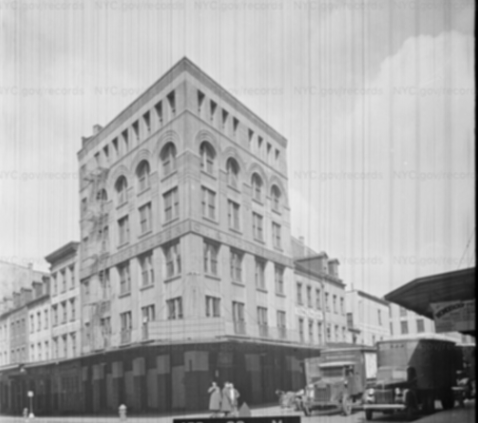
For his third attempt, poor Jimmy took poor Thomas over to the Fulton Market buildings. Two days later, when the cat didn’t come back, Benjamin congratulated Jimmy for finally getting rid of the cat. The congratulations were premature.
On the third day after Jimmy’s third attempt, the dye maker who originally owned Thomas saw the cat sitting outside on a window sill of the third floor. The cat was reportedly peering in at the dye maker at his work bench.
An investigation showed that Thomas had gotten into the adjoining building, climbed to the roof, and clambered to the window sill.
Realizing that traditional methods would not work on Thomas Wood, Benjamin Haskell called a meeting of his employees to determine the best way to get rid of the determined cat. Shooting him with a pistol was determined to be too brutal, but everyone agreed that asphyxiation would be the most humane way to do away with the feline.
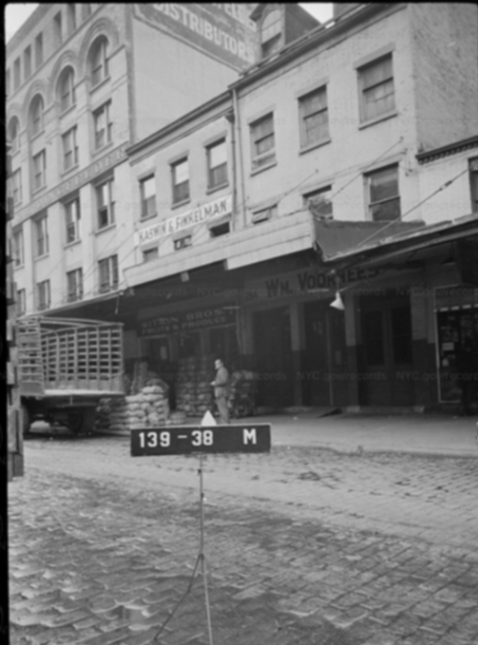
In order to carry out their dastardly deed, the dye maker got a large tin box and punched a hole in the side. They put the cat in the box and fastened the lid. Then the end of a rubber gas pipe was fitted to the hole and the gas was turned on. When they opened the box ten minutes later, Thomas was lying still with his eyes closed.
“He’s stone dead for sure,” said Jimmy as he shook the cat’s head. The office boy then wrapped the cat up in an old newspaper, put it in a cardboard box, and tied down the lid with twine. He took a trolley car to Bleecker and Thompson streets, where he tossed the box into an ash barrel.

Ten days later, just after the men had started work, the dye maker came running into the room with his eyes wide open. “Here he is!” he shouted to the men as he pointed toward the elevator shaft. Sure enough, there sat Thomas Wood, with his black coat as glossy as ever, giving himself his customary morning bath.
“Well, I’ll be blowed,” Jimmy said as he sank back limp against the shop wall. Benjamin walked over and called to the cat. Thomas trotted over and rubbed against his leg, purring happily.
“Gentlemen,” Benjamin said to his dumfounded employees, “I think we would be safe in assuming that this is in all probability the most remarkable occurrence that ever happened in the city of New York.”
Now, I don’t know if this story is completely true. But as little Virginia O’Hanlon’s father wrote, “If you see it in The Sun, it’s so.”
A Brief History of Washington Street
Named for George, Washington Street was proposed by 1785 and named and opened by 1797. Also labeled as “Low Water Street” in some late 18th- and early 19th-century deeds, the street was paved with Belgian blocks. Chambers Street was named for John Chambers, a prominent lawyer, corporation counsel, alderman, Supreme Court Judge and officer of Trinity Church from 1727 to his death around 1765.
The area of Washington and Chambers streets where the story of Thomas Wood took place was on the southwestern edge of a 62-acre farm granted to Roelof Janssen (Jansz or Jansen) in 1636 by Governor Van Twiller. The boundaries of this boot-shaped farm were roughly from present-day Warren Street north along Broadway to Duane Street, then northwest to Canal Street.
Following Janssen’s death, his widow, Annetje Jans, married Dominie Everardus Bogardus, the second pastor of the Reformed Dutch Church in New Amsterdam. The farm, which became known as the Dominie’s Bouwerie, featured a tobacco house and plantation that Bogardus leased to other farmers until his death at sea in 1647.

In 1670, Governor Francis Lovelace purchased Annetje’s land and added it to the Company’s Bouwerie, which was now being called the Duke’s Farm. Under English rule, the Duke’s Farm became the King’s Farm, and later, when Queen Anne began her reign in 1702, the Queen’s Farm. In 1705, Queen Anne granted the farm to Trinity Church, which in turn sold parcels of land for development.
290 Washington Street
Before there was a six-story brick factory building on the site, 290 Washington Street was a three-story brick house constructed sometime around 1830. The factory building was constructed around 1886.
In July 1899, the building was heavily damaged in a four-alarm fire. The building was then occupied by William M. Hines, dealer in fruits, on the ground floor; the American Wood Decorating Machine Company on the third floor; and William H. Cummings & Sons, dealers in scrap rubber, on the second and fourth through sixth floors.
When the fire started, most of the employees were out of the building on their lunch break; those few inside were all able to escape. One woman living in an adjacent four-story building on Chambers Street threatened to jump from a top window but a police officer ran up the stairs and got her out. As soon as she was safely outdoors, she ran back into her apartment to save her pet parrot.
The New York Times did not report on whether any cats escaped, but I have a feeling if Tommy Wood was in the building, he would have made it out safely.
Today, the site of 290 Washington Street is the two-acre Washington Market Community Park.
The Washington Street Urban Renewal Project
The Washington Street Urban Renewal Project brought down twenty-four and a half blocks of mostly 19th-century buildings on the west side of Lower Manhattan. Many of the buildings had been in continuous commercial use since before the Civil War as part of the Washington Street produce market. The market, located in the area since the War of 1812, was moved one day to new quarters in Hunts Point, the Bronx. The silence left in the streets was startling. As one wanderer put it, everyone left one night, even the dogs and the rats. –Danny Lyon, The Destruction of Lower Manhattan (Toronto: The Macmillan Company, 1969)
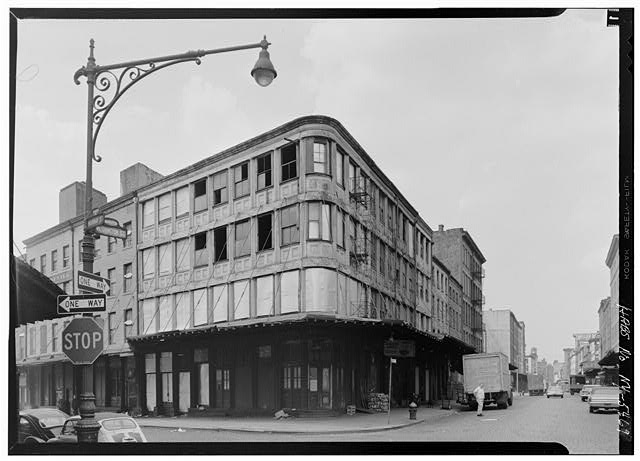
In 1962, much of western Tribeca (38 acres) was restructured and developed as part of the Housing and Development Administration’s Washington Street Urban Renewal Plan. The project comprised a narrow site twelve blocks long (Barclay to Hubert Streets) by two blocks wide.

After all the old buildings were demolished or preserved (a few historic buildings were physically moved), the site was built up with three 39-story housing towers, a complex for Manhattan Community College, an elementary school, middle school, and an office building. The land at Washington and Chambers streets was left vacant and utilized as a parking lot for many years.
By the early 1970s, the site on which Washington Market Community Park is now located was listed in the plan as a “public open space.” Neighborhood activists wanted to create a park, and so in 1978, through much community effort, a park was created, bringing much-needed green space to lower Manhattan again.
Sadly, no dogs are allowed in the park, so one must assume that cats are also prohibited.

Upcoming Events
The Seafaring Cats of Gotham. July 14, 7 p.m. ET.
Click here to register.




I’m so happy Thomas survived! I wish he could have found kinder people to stay with, though…. His story makes me think of the song “The Cat Came Back”, which was apparently written only a few years before! Maybe persistent felines were an 1890’s thing! Thanks as always for another amazing NY animal story!
It’s so funny you say that! I literally just posted the story on Twitter using the lyrics from The Cat Came Back. The song was written by a New Yorker in 1893. https://hatchingcatnyc.com/2018/04/18/minnie-ship-cat-pier55/
Wow, how crazy that it was written by a New Yorker!